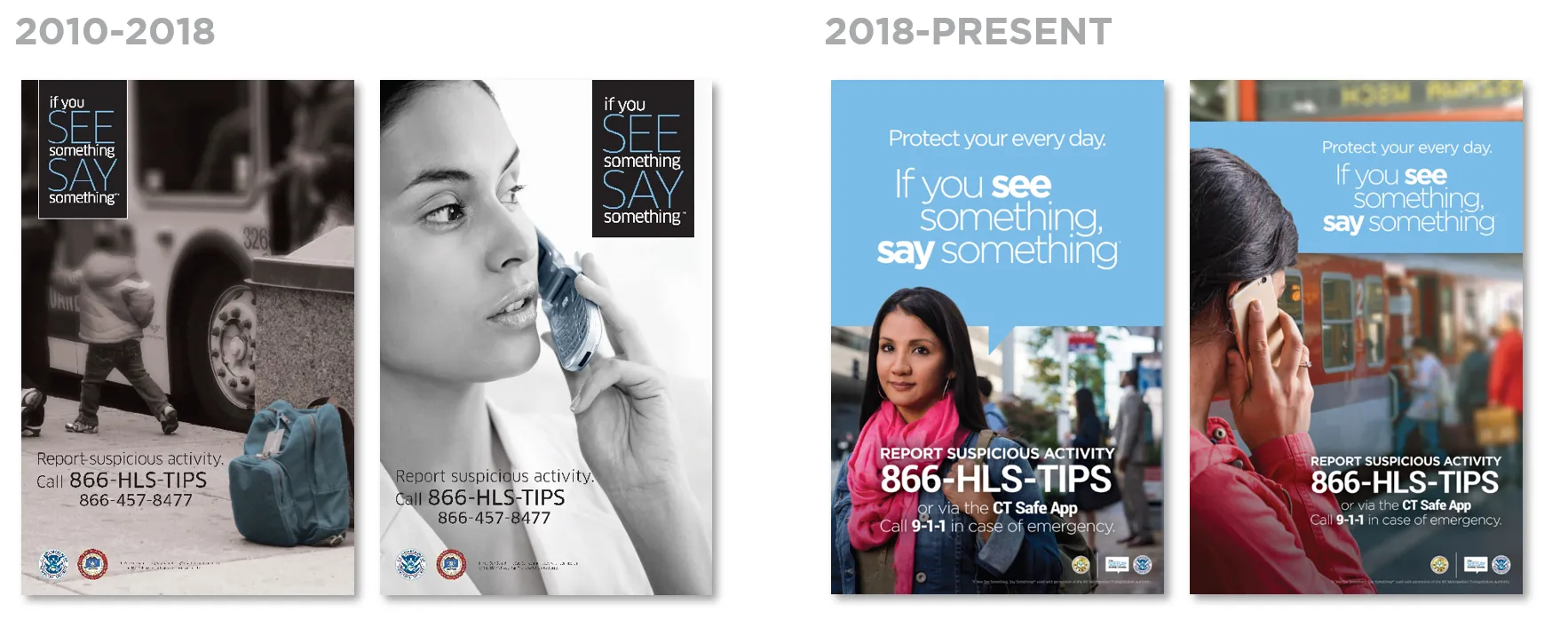Campaign Mission
The U.S. Department of Homeland Security’s (DHS) "If You See Something, Say Something®" program is a national campaign whose mission is to raise public awareness in two primary areas:
- Recognizing signs that may indicate a potential nexus to terrorism.
- How to report suspicious activity to appropriate law enforcement authorities.
To accomplish this effort, DHS disseminates outreach materials and public service announcements, as well as builds strategic partnerships with organizations in the private and public sector who help amplify the campaign’s message in their communities. The campaign works with these partners year-round to empower and educate the public on the importance of reporting suspicious activity.
History
The slogan "If You See Something, Say Something®" was originally implemented and trademarked by the New York Metropolitan Transportation Authority (NY MTA) after a terrorist attack on September 11, 2001. In July 2010, the NY MTA granted a license to DHS to use the trademarked slogan for the purpose of implementing a nationwide anti-terrorism campaign.
The DHS campaign was launched in conjunction with the Nationwide Suspicious Activity Reporting Initiative. Since the DHS campaign’s launch in 2010, it has partnered with organizations to raise awareness in communities across the country. The campaign partners with state and local governments, federal agencies, major sports leagues, transit stations, entertainment venues, private businesses, places of worship, nonprofits, and many other types of organizations. These partnerships have been critical to the success of the campaign. Learn how your organization can participate in the campaign.
In particular, the campaign has worked closely with U.S. states and territories to determine each area's appropriate process for reporting suspicious activity, and has created bundles of campaign materials that can be used by organizations within their specific state or jurisdiction.
In 2018, DHS designated September 25 as National “If You See Something, Say Something®” Awareness Day, also known as #SeeSayDay. On this day, DHS and its campaign partners across the country come together to remind the public to be aware of suspicious activity and know how to report it to law enforcement.
Over the years, the campaign’s materials have been redesigned and they will continue to be in the future. However, the core message has remained the same since the DHS campaign began: “If You See Something, Say Something®.”
Additional Resources
National Terrorism Advisory System (NTAS)
The National Terrorism Advisory System (NTAS) is designed to alert the public about a specific or imminent terrorist threat or about a change in the terrorism threat level.
Homeland Threat Assessment (HTA)
The Homeland Threat Assessment (HTA) provides the U.S. Department of Homeland Security's analysis of the current threat landscape and provides a detailed report on the most pressing threats facing the country over the next year. This assessment enables our partners across state, local, tribal, and territorial government, along with the private and non-profit sectors, to make better informed decisions that account for these security challenges.
The Nationwide Suspicious Activity Reporting (SAR) Initiative (NSI) is a joint collaborative effort by DHS, the Federal Bureau of Investigation, and law enforcement partners. It establishes standard processes and policies that allow law enforcement and homeland security agencies to share Suspicious Activity Reports through an information-sharing system. The initiative was set up in a manner that protects a person’s privacy, civil rights, and civil liberties.
Trainings for Frontline Officers
The NSI has developed training programs for frontline officers and hometown security partners on how to document and verify behavior that may indicate terrorism-related criminal activity. These trainings discuss how to report identified suspicious activity to the proper authorities, while maintaining the protection of citizens' privacy, civil rights, and civil liberties.
NTER Master Trainer Program
The DHS National Threat Evaluation and Reporting Office offers a Master Trainer Program to federal, state, local, tribal, and territorial homeland security professionals on how to take a behavioral approach to violence prevention when identifying and mitigating threats of targeted violence. Completion of the program provides professionals with a certification to train others on Behavioral Threat Assessment and Management techniques and best practices. Certified Master Trainers receive exclusive access to key training and program resources.
DHS’ most important mission is to protect the American people. As part of this mission, DHS fosters collaboration between the private sector and the public sector to mitigate risk and enhance the security and resilience of critical infrastructure, public gathering sites, and special events. CISA provides security resources to organizations on how to secure public gatherings, protect places of worship, prepare businesses, mitigate bomb threats, and more.
Download the DHS Hometown Security fact sheet that lists additional DHS resources available to you.
SchoolSafety.gov
The U.S. Department of Homeland Security, U.S. Department of Education, U.S. Department of Justice, and the U.S. Department of Health and Human Services created SchoolSafety.gov to share actionable recommendations to keep school communities safe. SchoolSafety.gov aims to help schools prevent, protect, mitigate, respond to, and recover from a range of school safety threats, hazards, and emergency situations.
K-12 School Security Guide and Companion Products
The Cybersecurity and Infrastructure Security Agency’s K-12 School Security Guide provides a comprehensive doctrine and systems-based methodology to support schools in conducting vulnerability assessments and planning to implement layered physical security elements across K–12 districts and campuses. The primary focus will be on protection and mitigation measures and strategies schools should consider in their broader school safety enterprise.
In partnership with the DHS Center for Faith-Based and Neighborhood Partnerships and the Faith-Based Information Sharing and Analysis Organization, the Cybersecurity and Infrastructure Security Agency provides faith-based resources to support efforts to maintain safe and secure houses of worship and related facilities while sustaining an open and welcoming environment.

